Antibody Production Market
Antibody Production Market Size and Share Forecast Outlook 2025 to 2035
Antibody production market is projected to grow from USD 17.0 billion in 2025 to USD 50.3 billion by 2035, at a CAGR of 11.4%. Instruments will dominate with a 56.4% market share, while monoclonal antibody will lead the type segment with a 64.0% share.
Antibody Production Market Forecast and Outlook 2025 to 2035
The global antibody production market is projected to grow from USD 17.03 billion in 2025 to approximately USD 50.3 billion by 2035, expanding at a compound annual growth rate (CAGR) of 11.4% between 2025 and 2035. The market is positioned for substantial expansion, driven by accelerating therapeutic antibody development pipelines, expanding biologics manufacturing capacity, and increasing adoption of advanced bioprocessing technologies across biopharmaceutical companies, contract development and manufacturing organizations, and academic research institutions globally.
The market demonstrates robust fundamentals supported by growing deployment of single-use bioproduction systems, pharmaceutical manufacturers' focus on production efficiency optimization, and rising recognition of antibody therapeutics as transformative treatment modalities in achieving breakthrough clinical outcomes, precision medicine advancement, and sustainable biomanufacturing economics within modern pharmaceutical development architectures across diverse therapeutic applications.
Quick Stats on Antibody Production Market
- Antibody Production Market Value (2025): USD 17.03 billion
- Antibody Production Market Forecast Value (2035): USD 50.3 billion
- Antibody Production Market Forecast CAGR (2025 to 2035): 11.4%
- Leading Product in Antibody Production Market: Consumables (56.4%)
- Leading Process in Antibody Production Market: Downstream Processing (52.0%)
- Leading Type in Antibody Production Market: Monoclonal Antibody (64.0%)
- Key Growth Regions in Antibody Production Market: North America, Asia Pacific, and Europe
- Key Players in Antibody Production Market: Danaher Corporation, Thermo Fisher Scientific, Sartorius, Merck KGaA, Eppendorf, Lonza Group, AGC Biologics, Wuxi Biologics, Charles River Laboratories, Biointron
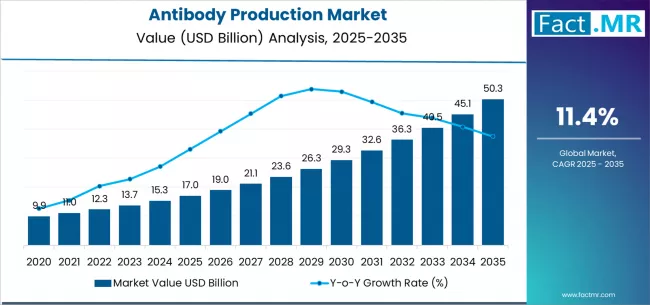
Market growth is underpinned by technological innovations in antibody production platforms, particularly downstream purification systems and chromatography technologies, which offer enhanced product recovery, improved purity specifications, and superior process economics compared to conventional bioprocessing approaches prevalent in early-stage antibody manufacturing. Biopharmaceutical organizations and CDMO providers increasingly prioritize production solutions that deliver optimal balance between process efficiency, product quality assurance, and manufacturing scalability while adhering to increasingly sophisticated quality-by-design principles and regulatory compliance requirements across global biomanufacturing markets. The convergence of monoclonal antibody therapeutic expansion in oncology and immunology indications, biosimilar antibody production acceleration in cost-competitive markets, and next-generation antibody format development including bispecific antibodies and antibody-drug conjugates creates multifaceted growth opportunities for bioprocessing equipment manufacturers and consumable suppliers.
Advanced antibody production technologies incorporating continuous bioprocessing platforms, automated purification systems, and single-use bioprocessing assemblies are improving manufacturing efficiency, reducing contamination risks, and enhancing production flexibility across biomanufacturing operations. The market's trajectory reflects the biopharmaceutical industry's unprecedented investment in antibody therapeutic development representing majority of biologics pipelines, the expanding role of contract manufacturing organizations in outsourced antibody production, and the growing integration of advanced analytics and process automation enabling real-time quality monitoring. Blockbuster antibody therapeutic commercialization programs and biosimilar antibody production initiatives are establishing comprehensive frameworks for manufacturing excellence, while Industry 4.0 technology adoption enables enhanced process understanding and seamless manufacturing execution system connectivity across global antibody production operations.
Between 2020 and 2025, the antibody production market expanded from USD 11.8 billion to USD 17.03 billion, demonstrating strong foundational growth driven by global therapeutic antibody pipeline expansion, increasing biosimilar antibody manufacturing activity, and accelerated deployment of single-use bioprocessing technologies across pharmaceutical manufacturing facilities and contract production organizations. This growth phase established modern bioprocessing infrastructure, validated continuous manufacturing approaches, and created comprehensive supplier ecosystems supporting global antibody therapeutic production.
From 2025 to 2030, the market is projected to accelerate substantially, reaching USD 28.6 billion, representing a critical inflection point as multiple blockbuster antibody therapeutics achieve commercial launch requiring large-scale manufacturing capacity, as bispecific antibodies and antibody-drug conjugates transition from development to commercial production, and as emerging market CDMO capacity enables global supply chain diversification. This period will be characterized by intensive manufacturing capacity expansion, enhanced automation platform deployment, and widespread adoption of advanced downstream processing technologies across all biomanufacturing scales.
From 2030 to 2035, the market is forecast to reach USD 50.3 billion, driven by mature antibody therapeutic market supporting dozens of commercial products across therapeutic areas, next-generation antibody format manufacturing requiring sophisticated production capabilities, and comprehensive pharmaceutical industry reliance on antibody platforms as foundational therapeutic modality. The growing adoption of perfusion culture systems, integration of artificial intelligence in process optimization, and establishment of distributed manufacturing networks will drive demand for advanced antibody production systems with proven scalability and established regulatory compliance capabilities.
Antibody Production Market Key Takeaways
| Metric | Value |
|---|---|
| Estimated Value (2025E) | USD 17.03 billion |
| Forecast Value (2035F) | USD 50.3 billion |
| Forecast CAGR (2025 to 2035) | 11.4% |
Why is the Antibody Production Market Growing?
Market expansion is being supported by the extraordinary growth in therapeutic antibody development pipelines and the corresponding need for scalable manufacturing infrastructure in biopharmaceutical production across global pharmaceutical operations. Modern biopharmaceutical companies recognize that monoclonal antibodies represent the dominant therapeutic modality in oncology, immunology, and rare disease drug development, requiring comprehensive manufacturing capabilities spanning cell line development through commercial-scale production.
The proven clinical success of antibody therapeutics achieving blockbuster commercial status makes production capacity and process expertise essential components of biopharmaceutical development strategies and commercial launch preparation programs. The growing emphasis on biosimilar antibody development and contract manufacturing outsourcing is driving demand for advanced production technologies that meet stringent quality specifications and regulatory requirements for biopharmaceutical applications.
Pharmaceutical sponsors' requirement for flexible, cost-effective manufacturing solutions that ensure consistent product quality while supporting rapid clinical development timelines creates opportunities for innovative bioprocessing technologies and comprehensive CDMO service offerings. The rising influence of next-generation antibody formats including bispecific antibodies and antibody-drug conjugates requiring specialized production capabilities is accelerating adoption of advanced manufacturing platforms across different development stages and commercial scales.
Opportunity Pathways - Antibody Production Market
The antibody production market represents a transformative biomanufacturing opportunity, expanding from USD 17.03 billion in 2025 to USD 50.3 billion by 2035 at an 11.4% CAGR. As biopharmaceutical organizations prioritize antibody therapeutic development, manufacturing efficiency optimization, and commercial production scalability in pharmaceutical portfolios, antibody production systems have evolved from laboratory research tools to essential biomanufacturing infrastructure enabling therapeutic candidate advancement, biosimilar development acceleration, and next-generation antibody format commercialization across blockbuster oncology franchises and specialty immunology applications.
The convergence of therapeutic antibody pipeline expansion, biosimilar manufacturing acceleration, advanced bioprocessing technology maturation, and pharmaceutical outsourcing growth creates substantial demand momentum. High-performance consumables supporting reliable upstream and downstream processing, established downstream purification systems delivering product quality and recovery optimization, and comprehensive monoclonal antibody production platforms serving dominant therapeutic modality will capture market leadership, while geographic expansion into cost-competitive Asian manufacturing regions and therapeutic diversification into novel antibody formats will enable market participation. Pharmaceutical industry antibody therapeutic dependence and biomanufacturing infrastructure requirements provide unprecedented growth foundation.
- Pathway A - Consumables Product Dominance: Leading with 56.4% market share, consumables drive primary demand through media, buffers, reagents, chromatography resins, and filtration products supporting all antibody production stages. Essential consumable products enabling cell culture, purification, and formulation processes command recurring revenue from biopharmaceutical manufacturers requiring consistent quality materials for GMP production operations. Expected revenue pool: USD 9.6-28.4 billion.
- Pathway B - Downstream Processing Leadership: Dominating with 52.0% process share through purification, filtration, chromatography, and polishing operations, downstream processing serves critical product recovery and quality specification achievement requirements. This process addresses both product purity mandates and regulatory compliance expectations, making it essential infrastructure for biopharmaceutical organizations pursuing commercial antibody manufacturing. Opportunity: USD 8.9-26.2 billion.
- Pathway C - Asian Manufacturing Emergence: China (12.8% CAGR) and India (12.3% CAGR) lead global growth through expanding biopharma infrastructure, government manufacturing incentives, and cost-competitive CDMO capacity development. Strategic manufacturing establishment in Asian markets, leveraging technical expertise and economic advantages, enables market leadership supporting both biosimilar production and pharmaceutical outsourcing demand. Geographic expansion upside: USD 5.8-17.1 billion.
- Pathway D - Monoclonal Antibody Type Dominance: Monoclonal antibodies with 64.0% type share serve overwhelmingly dominant therapeutic modality requiring comprehensive production infrastructure for therapeutic, diagnostic, and research applications. Established mAb production platforms supporting therapeutic development, biosimilar manufacturing, and next-generation formats maintain essential market foundation from pharmaceutical sponsors and CDMO providers. Type revenue potential: USD 10.9-32.2 billion.
- Pathway E - Advanced Bioprocessing Technology & Automation: Companies investing in continuous manufacturing platforms, automated purification systems, and single-use bioprocessing technologies gain competitive advantages through enhanced efficiency and reduced contamination risks. Advanced capabilities enabling flexible manufacturing, rapid changeover, and comprehensive process analytical technology integration capture premium market positioning. Technology differentiation premium: USD 3.4-10.1 billion.
- Pathway F - CDMO Service Expansion & Integrated Solutions: Contract manufacturing organizations offering end-to-end antibody production services, integrated process development, and regulatory support create competitive differentiation in outsourced biomanufacturing markets. Companies providing comprehensive manufacturing solutions, technical expertise, and global capacity networks gain preferred partner status with pharmaceutical sponsors requiring scalable production capabilities. CDMO service value: USD 2.9-8.5 billion.
- Pathway G - Next-Generation Antibody Formats & Specialized Production: Beyond conventional monoclonal antibodies, bispecific antibodies, antibody-drug conjugates, and novel antibody fragments represent emerging opportunities requiring specialized production capabilities. Companies developing advanced manufacturing platforms, supporting innovative therapeutic formats, and establishing differentiated technical expertise capture first-mover advantages in expanding therapeutic categories. Format diversification opportunity: USD 2.4-7.0 billion.
Segmental Analysis
The market is segmented by product, type, process, end use, and region. By product, the market is divided into instruments, consumables, and software. Based on type, the market is categorized into monoclonal antibody and polyclonal antibody. By process, the market is segmented into upstream and downstream.
By end use, the market is segmented into pharmaceutical & biotechnology companies, research laboratories, and CROs & CDMOs. Regionally, the market is divided into Asia Pacific, North America, Europe, Latin America, and Middle East & Africa.
How do Consumables Drive Product Segment Leadership?
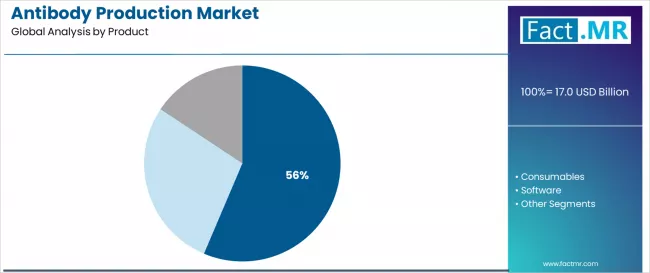
The consumables product segment is projected to account for 56.4% of the antibody production market in 2025, establishing dominant position as the recurring revenue driver supporting all manufacturing operations. Biopharmaceutical manufacturers and CDMO providers recognize that consumable products including cell culture media, purification buffers and reagents, chromatography resins, and filtration membranes represent essential materials requiring continuous replenishment throughout production campaigns.
This product category addresses both upstream cell culture and downstream purification requirements while providing predictable recurring revenue streams for suppliers serving biomanufacturing operations. This segment forms the foundation of biomanufacturing economics and supplier business models, as consumables generate ongoing revenues tied directly to production volumes and campaign frequencies unlike capital equipment representing one-time investments.
Quality consistency and supply reliability continue strengthening customer loyalty for consumable suppliers among biopharmaceutical quality assurance and procurement organizations managing critical production materials. With expanding therapeutic antibody manufacturing volumes and growing CDMO production campaigns, consumable demand will maintain its central position driving overall market revenue throughout the forecast period as biomanufacturing activity intensifies globally.
Why does Downstream Processing Command Majority Process Share?
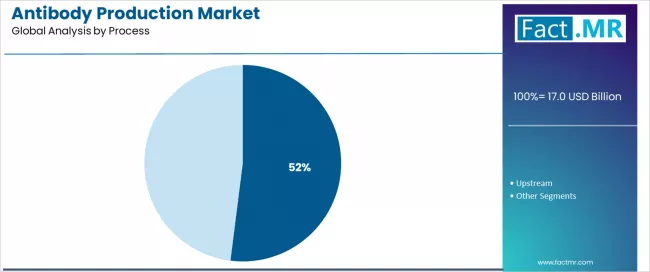
Downstream processing is projected to represent 52.0% of antibody production process demand in 2025, underscoring its role as the value-determining manufacturing stage achieving product purity and quality specifications. Biomanufacturing organizations recognize that downstream operations including purification, chromatography, filtration, and polishing represent the most technically challenging and economically significant production phases determining final product quality, regulatory compliance, and manufacturing economics.
Downstream processing addresses both product recovery optimization and impurity removal requirements essential for achieving biopharmaceutical grade material specifications. The segment reflects the economic reality that downstream processing typically constitutes majority of production costs and represents the critical quality-determining operations in antibody manufacturing.
Technological advancement in downstream operations including continuous chromatography, single-use purification systems, and advanced filtration technologies continues improving process efficiency and product recovery rates. As product purity requirements increase with regulatory scrutiny, as biosimilar manufacturing demands cost-competitive processes, and as novel antibody formats require specialized purification approaches, downstream processing will maintain its essential role as the market's dominant process category within global antibody production operations.
What drives Monoclonal Antibody Type Segment Prominence?
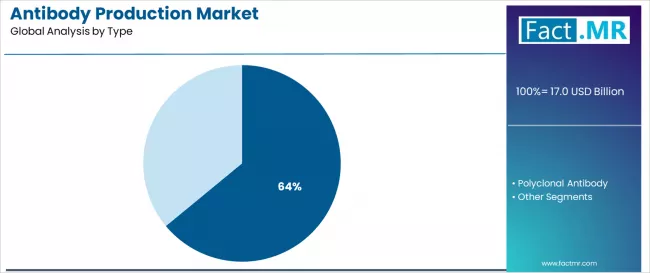
The monoclonal antibody type is projected to account for 64.0% of the antibody production market in 2025, establishing overwhelming dominance as the therapeutic format driving biopharmaceutical development and commercial manufacturing. Pharmaceutical organizations recognize that monoclonal antibodies represent the most clinically validated and commercially successful antibody format, with dozens of blockbuster therapeutic products across oncology, immunology, and other therapeutic areas generating hundreds of billions in annual sales.
This type addresses the broadest therapeutic applications and possesses the most established manufacturing infrastructure and regulatory precedents. The segment represents the convergence of proven therapeutic efficacy, established manufacturing platforms, comprehensive regulatory experience, and massive commercial market potential making monoclonal antibodies the dominant focus for pharmaceutical investment and production capacity allocation.
Biosimilar mAb development further amplifies manufacturing demand as patent expiries create opportunities for generic competition requiring substantial production capacity. As mAb therapeutic pipelines continue expanding, as biosimilar manufacturing accelerates, and as next-generation mAb formats build upon established platforms, monoclonal antibody production will maintain its foundational importance within the global biopharmaceutical manufacturing ecosystem.
What are the Drivers, Restraints, and Key Trends of the Antibody Production Market?
The antibody production market is experiencing robust growth due to pharmaceutical industry's unprecedented reliance on antibody therapeutics and the corresponding manufacturing infrastructure requirements supporting clinical development and commercial supply. However, the market faces challenges, including high capital investment requirements for GMP manufacturing facilities limiting new capacity development, technical complexity of antibody production processes requiring specialized expertise, and regulatory compliance burdens creating substantial quality system and validation requirements. Continuous technological innovation and regulatory evolution continues influencing market dynamics and manufacturing approaches.
Therapeutic Antibody Pipeline Expansion and Commercial Success
The extraordinary growth of therapeutic antibody development pipelines across pharmaceutical and biotechnology companies creates sustained demand for production capabilities supporting all development stages from research through commercial manufacturing. Blockbuster antibody therapeutics achieving multi-billion dollar annual sales including checkpoint inhibitors, TNF inhibitors, and targeted oncology antibodies validate the therapeutic approach driving continued pharmaceutical investment. Clinical success rates for antibody therapeutics exceeding other modalities combined with favorable regulatory reception create compelling development economics supporting aggressive pipeline expansion requiring corresponding manufacturing capacity growth.
Biosimilar Manufacturing Acceleration and CDMO Capacity Expansion
The accelerating biosimilar antibody market following major biologic patent expiries creates substantial manufacturing demand as multiple biosimilar developers pursue each originator target requiring independent production capacity. Contract manufacturing organizations responding to pharmaceutical outsourcing trends invest heavily in flexible antibody production facilities supporting multiple client programs and product types. CDMO capacity expansion particularly in cost-competitive Asian markets enables global supply chain diversification while providing pharmaceutical sponsors access to manufacturing capabilities without capital-intensive internal facility development.
Analysis of the Antibody Production Market by Key Countries
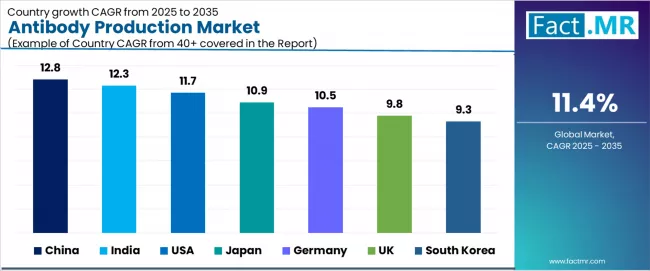
| Country | CAGR (2025-2035) |
|---|---|
| China | 12.8% |
| India | 12.3% |
| usa | 11.7% |
| Japan | 10.9% |
| Germany | 10.5% |
| UK | 9.8% |
| South Korea | 9.3% |
The antibody production market is experiencing substantial growth globally, with China leading at a 12.8% CAGR through 2035, driven by expanding biopharma infrastructure, high adoption of advanced production technologies, and government incentives supporting domestic biomanufacturing capability development. India follows at 12.3%, supported by rising demand for therapeutic antibodies, increasing biologics manufacturing capacity, and cost-competitive CDMO services attracting international pharmaceutical partnerships.
The USA records 11.7% growth, benefiting from leading therapeutic antibody pipeline, established biomanufacturing infrastructure, and comprehensive CDMO service sector. Japan demonstrates 10.9% growth, emphasizing precision biomanufacturing capabilities and pharmaceutical industry investment.
Germany shows 10.5% growth, representing bioprocessing technology leadership and pharmaceutical manufacturing excellence. UK records 9.8% growth with academic research strength and biosimilar development activity, while South Korea shows 9.3% growth, representing accelerated biosimilar development and CDMO outsourcing expansion.
How Does China Demonstrate Exceptional Market Potential with Infrastructure Expansion?
Revenue from antibody production in China is projected to exhibit exceptional growth with a CAGR of 12.8% through 2035, driven by expanding biopharma infrastructure and increasing recognition of biomanufacturing capabilities as strategic national priority supporting pharmaceutical industry advancement.
The country's aggressive biopharmaceutical sector investment and comprehensive government incentive programs are creating unprecedented opportunities for antibody production capacity development serving both domestic therapeutic development and international CDMO market opportunities.
Major Chinese biomanufacturing organizations and multinational corporations are establishing state-of-the-art antibody production facilities equipped with advanced bioprocessing technologies throughout China's major biopharma clusters. The Chinese government's biopharmaceutical development policies and manufacturing capability building initiatives drive substantial investments in production infrastructure, technical expertise development, and regulatory system modernization.
This policy framework, combined with the country's cost-competitive manufacturing economics and rapidly developing technical capabilities, creates exceptionally favorable environment for antibody production market expansion. Chinese CDMO providers capturing international pharmaceutical partnerships and domestic companies developing therapeutic antibody pipelines position China as emerging biomanufacturing powerhouse.
- Government biopharma policies and manufacturing incentives driving comprehensive antibody production infrastructure investment nationwide
- Technical capability development and advanced bioprocessing technology adoption supporting competitive manufacturing quality and efficiency
- CDMO sector expansion and international partnership establishment enabling Chinese manufacturers to serve global pharmaceutical market
- Biosimilar development acceleration and domestic therapeutic antibody pipelines driving sustained production capacity requirements
What Makes India Demonstrate Market Leadership with CDMO Capabilities?
Revenue from antibody production in India is expanding at a CAGR of 12.3%, supported by rising demand for therapeutic antibodies, increasing biologics manufacturing capacity, and established pharmaceutical industry expertise attracting international CDMO partnerships.
The country's leading biosimilar developers and contract manufacturers possess established antibody production capabilities serving both domestic and international markets with cost-competitive manufacturing.
India's substantial therapeutic market for antibody treatments and growing pharmaceutical development activity create expanding domestic demand while technical capabilities enable export-oriented production.
India's biopharmaceutical sector benefits from established pharmaceutical industry infrastructure, cost-competitive manufacturing advantages, and technical expertise developed through early biosimilar market entry.
The country's CDMO providers established strong international reputations supporting continued partnership growth and capacity expansion. This foundation enables sustained antibody production market growth as therapeutic portfolios expand and manufacturing capacity increases serving global pharmaceutical requirements.
- Rising therapeutic antibody demand and biosimilar market growth driving domestic production capacity expansion
- Biologics manufacturing capability development and quality system maturation supporting international pharmaceutical partnerships
- Cost-competitive production advantages and technical expertise enabling CDMO market leadership and partnership attraction
- Government pharmaceutical industry support and infrastructure investment facilitating continued capability development and capacity growth
Why Does USA Maintain Therapeutic Development and Manufacturing Leadership?
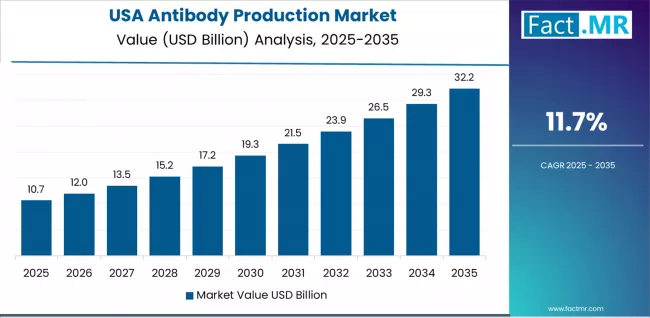
Revenue from antibody production in USA is projected to exhibit strong growth with a CAGR of 11.7% through 2035, driven by leading therapeutic antibody pipeline and established biomanufacturing infrastructure. The country's concentration of innovative biopharmaceutical companies and comprehensive CDMO sector create sustained demand for antibody production capabilities supporting clinical development through commercial manufacturing. American pharmaceutical organizations maintain the world's largest therapeutic antibody development pipelines requiring extensive manufacturing support across all development phases.
The USA market benefits from first-mover advantages in therapeutic antibody development, comprehensive biomanufacturing infrastructure including major CDMO facilities, and sophisticated regulatory environment supporting manufacturing excellence. This positioning supports sustained market growth as new therapeutic antibodies advance through development and as existing commercial products require ongoing production capacity.
Strategic Market Considerations:
- Therapeutic antibody development leadership and clinical trial activity driving sustained manufacturing demand across development scales
- Established CDMO sector and biomanufacturing infrastructure supporting pharmaceutical outsourcing and capacity flexibility
- Next-generation antibody format development and innovative therapeutic approaches requiring advanced manufacturing capabilities
- Regulatory expertise and quality system sophistication maintaining competitive advantages despite higher manufacturing costs
How Does Japan Maintain Precision Biomanufacturing Excellence?
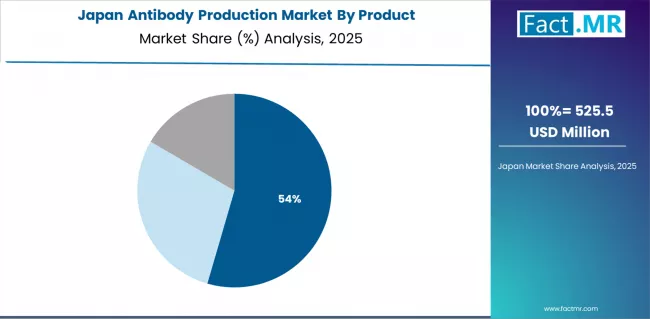
Japan's advanced biopharmaceutical market demonstrates sophisticated antibody production capabilities supporting a 10.9% CAGR through 2035. The country's precision biomanufacturing expertise and established pharmaceutical industry investment create demand for advanced production technologies and high-quality manufacturing services. Japanese biopharmaceutical companies and contract manufacturers leverage precision engineering capabilities and comprehensive quality management systems to establish differentiated production capabilities.
The Japanese market benefits from pharmaceutical industry investment in antibody therapeutic development, precision bioprocessing technology leadership, and quality-focused manufacturing culture supporting premium bioproduction services. This foundation enables sustained market participation as therapeutic antibody demand grows and manufacturing sophistication increases.
Strategic Market Considerations:
- Pharmaceutical company investment and therapeutic antibody development supporting domestic manufacturing demand
- Precision biomanufacturing expertise and quality system excellence enabling differentiated production capabilities
- Technology development and bioprocessing innovation supporting advanced manufacturing platform establishment
- Aging population demographics and therapeutic demand growth driving sustained antibody production requirements
What Drives Germany Market Growth with Bioprocessing Leadership?
Germany's established biopharmaceutical market demonstrates strong antibody production growth with a 10.5% CAGR through 2035, driven by bioprocessing technology leadership, pharmaceutical manufacturing excellence, and comprehensive equipment supplier ecosystem. The country's pharmaceutical industry concentration and precision engineering capabilities create advantages in biomanufacturing equipment development and production services. German bioprocessing equipment manufacturers and pharmaceutical companies maintain global leadership positions in antibody production technologies.
Market dynamics reflect integration of pharmaceutical industry demand with bioprocessing technology innovation and manufacturing service excellence important to German industrial strengths. Established biomanufacturing infrastructure and technical expertise create foundation for sustained market growth as antibody therapeutic development expands.
Strategic Market Considerations:
- Pharmaceutical industry presence and therapeutic antibody development driving domestic manufacturing requirements
- Bioprocessing equipment innovation and technology leadership supporting global market supply and competitive positioning
- Manufacturing excellence and quality system sophistication maintaining premium market positioning
- CDMO sector development and pharmaceutical outsourcing supporting capacity expansion and service diversification
How Does UK Demonstrate Research Excellence and Biosimilar Development?
UK's biopharmaceutical ecosystem demonstrates steady antibody production growth with a 9.8% CAGR through 2035 driven by academic research excellence and biosimilar development activity. The country's research institutions and biotechnology companies maintain strong antibody discovery and development capabilities creating manufacturing demand. UK pharmaceutical sector pursues biosimilar opportunities and therapeutic antibody development requiring production capacity support.
British biopharmaceutical sector benefits from academic research leadership, government life sciences investment, and established pharmaceutical industry presence supporting antibody production demand. This environment enables sustained market growth as therapeutic development advances and manufacturing requirements increase.
Strategic Market Considerations:
- Academic research excellence and antibody discovery capabilities creating pipeline of development candidates requiring manufacturing
- Biosimilar development programs and therapeutic antibody advancement driving production capacity requirements
- Life sciences investment and government support facilitating infrastructure development and capability building
- Pharmaceutical industry presence and CDMO sector supporting manufacturing service availability and capacity growth
Why Does South Korea Show Biosimilar Development Acceleration?
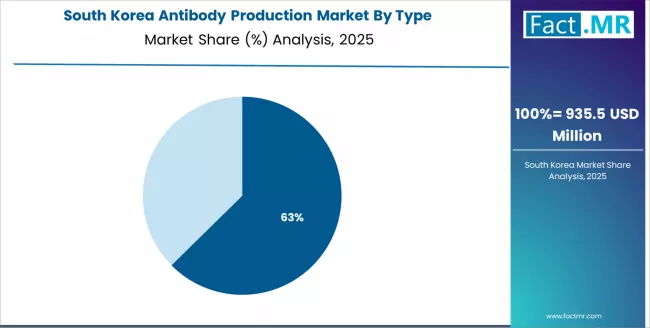
Revenue from antibody production in South Korea is projected to grow at a CAGR of 9.3% through 2035, driven by accelerated biosimilar development and CDMO outsourcing expansion. The country's biosimilar developers achieved early market success establishing technical capabilities and manufacturing infrastructure. Korean biopharmaceutical companies increasingly pursue global biosimilar opportunities requiring substantial production capacity while domestic CDMO sector attracts international partnerships.
The South Korean market benefits from biosimilar industry success, government biopharmaceutical support, and established manufacturing capabilities supporting continued market participation. This creates favorable environment for antibody production growth as biosimilar portfolios expand and CDMO services develop.
Strategic Market Considerations:
- Biosimilar development success and global market penetration driving sustained manufacturing capacity requirements
- CDMO sector development and international partnership attraction supporting production infrastructure expansion
- Government pharmaceutical industry support and export promotion facilitating capability development and market access
- Technical expertise accumulation and manufacturing quality advancement enabling competitive positioning in global markets
Europe Market Split by Country

The antibody production market in Europe is projected to grow from USD 4.5 billion in 2025 to USD 13.2 billion by 2035, registering a CAGR of 11.4% over the forecast period. Germany is expected to maintain its leadership position with a 32.8% market share in 2025, rising to 33.6% by 2035, supported by its bioprocessing equipment manufacturing leadership, comprehensive pharmaceutical industry presence, and advanced biomanufacturing infrastructure throughout established production operations.
The UK follows with a 24.2% share in 2025, projected to reach 24.8% by 2035, driven by academic research excellence, biosimilar development programs, and established pharmaceutical sector supporting antibody production requirements. France holds a 18.6% share in 2025, expected to increase to 18.9% by 2035, supported by pharmaceutical industry capabilities and biomanufacturing infrastructure. Switzerland commands a 14.8% share in 2025, projected to reach 14.2% by 2035, while Netherlands accounts for 6.4% in 2025, expected to reach 5.8% by 2035.
The rest of Europe region, including Nordic countries with biopharmaceutical innovation, Eastern European emerging manufacturing centers, and smaller Western European pharmaceutical markets, is anticipated to hold 3.2% in 2025, declining slightly to 2.7% by 2035, attributed to market consolidation toward larger core markets with established biopharmaceutical infrastructure and comprehensive antibody production capabilities.
Competitive Landscape of the Antibody Production Market
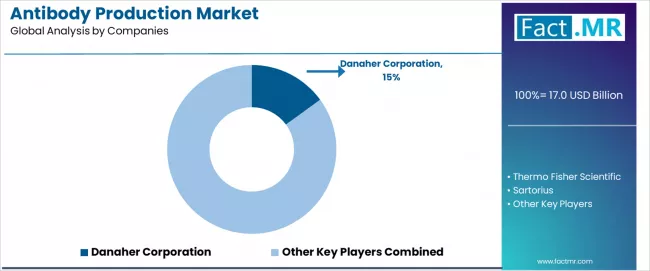
The antibody production market is characterized by intense competition among established life sciences companies, specialized bioprocessing equipment manufacturers, and integrated contract manufacturing organizations focused on delivering reliable, innovative, and scalable antibody production solutions.
Companies are investing in bioprocessing technology advancement, consumable product portfolio expansion, strategic biopharmaceutical customer partnerships, and comprehensive technical support integration to deliver effective, efficient, and compliant manufacturing solutions meeting rigorous biopharmaceutical quality standards and pharmaceutical development requirements.
Single-use technology innovation, continuous processing platform development, and automation integration strategies are central to strengthening competitive position and customer relationships.
Danaher Corporation leads the market with a 15.0% market share, offering comprehensive antibody production solutions through integrated business units providing bioprocessing equipment, consumables, and analytical instruments for biomanufacturing applications.
Thermo Fisher Scientific provides extensive life sciences portfolio including cell culture systems, purification technologies, and analytical capabilities across global biopharmaceutical markets.
Sartorius focuses on bioprocessing solutions emphasizing single-use technologies and integrated process platforms serving pharmaceutical manufacturing. Merck KGaA delivers comprehensive life science portfolio including bioprocessing materials and technologies.
Eppendorf operates bioprocess equipment and consumable businesses serving research and production applications. Lonza Group provides integrated CDMO services combining process development with commercial manufacturing capabilities.
AGC Biologics delivers contract manufacturing services specializing in antibody production across development scales. Wuxi Biologics operates large-scale CDMO platform serving global pharmaceutical clients with comprehensive antibody production services.
Charles River Laboratories and Biointron focus on specialized antibody production services and platform technologies supporting pharmaceutical development programs, emphasizing technical expertise and manufacturing quality through comprehensive service strategies.
Key Players in the Antibody Production Market
- Danaher Corporation
- Thermo Fisher Scientific
- Sartorius
- Merck KGaA
- Eppendorf
- Lonza Group
- AGC Biologics
- Wuxi Biologics
- Charles River Laboratories
- Biointron
Scope of the Report
| Items | Values |
|---|---|
| Quantitative Units (2025) | USD 17.03 Billion |
| Product | Media, Buffers & Reagents, Chromatography Resins & Columns, Filtration Consumables, Bioreactors, Downstream Equipment, Analytical Instruments |
| Process | Purification, Filtration, Chromatography, Polishing, Cell Culture, Formulation |
| Type | Therapeutic mAbs, Diagnostic mAbs, Next-Gen mAbs (Bispecifics, ADCs), Research mAbs, Polyclonal Antibodies |
| Regions Covered | North America, Europe, Asia Pacific, Latin America, mea |
| Countries Covered | usa, Germany, UK, Japan, India, China, South Korea and 40+ countries |
| Key Companies Profiled | Danaher Corporation, Thermo Fisher Scientific, Sartorius, Merck KGaA, Eppendorf, Lonza Group, AGC Biologics, Wuxi Biologics, Charles River Laboratories, Biointron |
| Additional Attributes | Dollar sales by product, process, type, regional demand trends, competitive landscape, biopharmaceutical company preferences for production technologies, integration with CDMO services, innovations in bioprocessing platforms, continuous manufacturing advancement, and quality system optimization capabilities |
Antibody Production Market by Segments
-
Product :
- Instruments
- Consumables
- Software
-
Type :
- Monoclonal Antibody
- Polyclonal Antibody
-
Process :
- Upstream
- Downstream
-
End Use :
- Pharmaceutical & Biotechnology Companies
- Research Laboratories
- CROs & CDMOs
-
Region :
-
North America
- usa
- Canada
- Mexico
-
Europe
- Germany
- France
- UK
- Italy
- Spain
- Nordic
- BENELUX
- Rest of Europe
-
Asia Pacific
- China
- India
- Japan
- South Korea
- ASEAN
- Australia & New Zealand
- Rest of Asia Pacific
-
Latin America
- Brazil
- Argentina
- Chile
- Rest of Latin America
-
mea
- Kingdom of Saudi Arabia
- Other GCC Countries
- Turkey
- South Africa
- Other African Countries
- Rest of mea
-
Table of Content
- Executive Summary
- Global Market Outlook
- Demand to side Trends
- Supply to side Trends
- Technology Roadmap Analysis
- Analysis and Recommendations
- Market Overview
- Market Coverage / Taxonomy
- Market Definition / Scope / Limitations
- Market Background
- Market Dynamics
- Drivers
- Restraints
- Opportunity
- Trends
- Scenario Forecast
- Demand in Optimistic Scenario
- Demand in Likely Scenario
- Demand in Conservative Scenario
- Opportunity Map Analysis
- Product Life Cycle Analysis
- Supply Chain Analysis
- Investment Feasibility Matrix
- Value Chain Analysis
- PESTLE and Porter’s Analysis
- Regulatory Landscape
- Regional Parent Market Outlook
- Production and Consumption Statistics
- Import and Export Statistics
- Market Dynamics
- Global Market Analysis 2020 to 2024 and Forecast, 2025 to 2035
- Historical Market Size Value (USD Million) Analysis, 2020 to 2024
- Current and Future Market Size Value (USD Million) Projections, 2025 to 2035
- Y to o to Y Growth Trend Analysis
- Absolute $ Opportunity Analysis
- Global Market Pricing Analysis 2020 to 2024 and Forecast 2025 to 2035
- Global Market Analysis 2020 to 2024 and Forecast 2025 to 2035, By Product
- Introduction / Key Findings
- Historical Market Size Value (USD Million) Analysis By Product, 2020 to 2024
- Current and Future Market Size Value (USD Million) Analysis and Forecast By Product, 2025 to 2035
- Instruments
- Consumables
- Software
- Y to o to Y Growth Trend Analysis By Product, 2020 to 2024
- Absolute $ Opportunity Analysis By Product, 2025 to 2035
- Global Market Analysis 2020 to 2024 and Forecast 2025 to 2035, By Type
- Introduction / Key Findings
- Historical Market Size Value (USD Million) Analysis By Type, 2020 to 2024
- Current and Future Market Size Value (USD Million) Analysis and Forecast By Type, 2025 to 2035
- Monoclonal Antibody
- Polyclonal Antibody
- Y to o to Y Growth Trend Analysis By Type, 2020 to 2024
- Absolute $ Opportunity Analysis By Type, 2025 to 2035
- Global Market Analysis 2020 to 2024 and Forecast 2025 to 2035, By Process
- Introduction / Key Findings
- Historical Market Size Value (USD Million) Analysis By Process, 2020 to 2024
- Current and Future Market Size Value (USD Million) Analysis and Forecast By Process, 2025 to 2035
- Downstream
- Upstream
- Y to o to Y Growth Trend Analysis By Process, 2020 to 2024
- Absolute $ Opportunity Analysis By Process, 2025 to 2035
- Global Market Analysis 2020 to 2024 and Forecast 2025 to 2035, By Region
- Introduction
- Historical Market Size Value (USD Million) Analysis By Region, 2020 to 2024
- Current Market Size Value (USD Million) Analysis and Forecast By Region, 2025 to 2035
- North America
- Latin America
- Western Europe
- Eastern Europe
- East Asia
- South Asia and Pacific
- Middle East & Africa
- Market Attractiveness Analysis By Region
- North America Market Analysis 2020 to 2024 and Forecast 2025 to 2035, By Country
- Historical Market Size Value (USD Million) Trend Analysis By Market Taxonomy, 2020 to 2024
- Market Size Value (USD Million) Forecast By Market Taxonomy, 2025 to 2035
- By Country
- USA
- Canada
- Mexico
- By Product
- By Type
- By Process
- By Country
- Market Attractiveness Analysis
- By Country
- By Product
- By Type
- By Process
- Key Takeaways
- Latin America Market Analysis 2020 to 2024 and Forecast 2025 to 2035, By Country
- Historical Market Size Value (USD Million) Trend Analysis By Market Taxonomy, 2020 to 2024
- Market Size Value (USD Million) Forecast By Market Taxonomy, 2025 to 2035
- By Country
- Brazil
- Chile
- Rest of Latin America
- By Product
- By Type
- By Process
- By Country
- Market Attractiveness Analysis
- By Country
- By Product
- By Type
- By Process
- Key Takeaways
- Western Europe Market Analysis 2020 to 2024 and Forecast 2025 to 2035, By Country
- Historical Market Size Value (USD Million) Trend Analysis By Market Taxonomy, 2020 to 2024
- Market Size Value (USD Million) Forecast By Market Taxonomy, 2025 to 2035
- By Country
- Germany
- UK
- Italy
- Spain
- France
- Nordic
- BENELUX
- Rest of Western Europe
- By Product
- By Type
- By Process
- By Country
- Market Attractiveness Analysis
- By Country
- By Product
- By Type
- By Process
- Key Takeaways
- Eastern Europe Market Analysis 2020 to 2024 and Forecast 2025 to 2035, By Country
- Historical Market Size Value (USD Million) Trend Analysis By Market Taxonomy, 2020 to 2024
- Market Size Value (USD Million) Forecast By Market Taxonomy, 2025 to 2035
- By Country
- Russia
- Poland
- Hungary
- Balkan & Baltic
- Rest of Eastern Europe
- By Product
- By Type
- By Process
- By Country
- Market Attractiveness Analysis
- By Country
- By Product
- By Type
- By Process
- Key Takeaways
- East Asia Market Analysis 2020 to 2024 and Forecast 2025 to 2035, By Country
- Historical Market Size Value (USD Million) Trend Analysis By Market Taxonomy, 2020 to 2024
- Market Size Value (USD Million) Forecast By Market Taxonomy, 2025 to 2035
- By Country
- China
- Japan
- South Korea
- By Product
- By Type
- By Process
- By Country
- Market Attractiveness Analysis
- By Country
- By Product
- By Type
- By Process
- Key Takeaways
- South Asia and Pacific Market Analysis 2020 to 2024 and Forecast 2025 to 2035, By Country
- Historical Market Size Value (USD Million) Trend Analysis By Market Taxonomy, 2020 to 2024
- Market Size Value (USD Million) Forecast By Market Taxonomy, 2025 to 2035
- By Country
- India
- ASEAN
- Australia & New Zealand
- Rest of South Asia and Pacific
- By Product
- By Type
- By Process
- By Country
- Market Attractiveness Analysis
- By Country
- By Product
- By Type
- By Process
- Key Takeaways
- Middle East & Africa Market Analysis 2020 to 2024 and Forecast 2025 to 2035, By Country
- Historical Market Size Value (USD Million) Trend Analysis By Market Taxonomy, 2020 to 2024
- Market Size Value (USD Million) Forecast By Market Taxonomy, 2025 to 2035
- By Country
- Kingdom of Saudi Arabia
- Other GCC Countries
- Turkiye
- South Africa
- Other African Union
- Rest of Middle East & Africa
- By Product
- By Type
- By Process
- By Country
- Market Attractiveness Analysis
- By Country
- By Product
- By Type
- By Process
- Key Takeaways
- Key Countries Market Analysis
- USA
- Pricing Analysis
- Market Share Analysis, 2024
- By Product
- By Type
- By Process
- Canada
- Pricing Analysis
- Market Share Analysis, 2024
- By Product
- By Type
- By Process
- Mexico
- Pricing Analysis
- Market Share Analysis, 2024
- By Product
- By Type
- By Process
- Brazil
- Pricing Analysis
- Market Share Analysis, 2024
- By Product
- By Type
- By Process
- Chile
- Pricing Analysis
- Market Share Analysis, 2024
- By Product
- By Type
- By Process
- Germany
- Pricing Analysis
- Market Share Analysis, 2024
- By Product
- By Type
- By Process
- UK
- Pricing Analysis
- Market Share Analysis, 2024
- By Product
- By Type
- By Process
- Italy
- Pricing Analysis
- Market Share Analysis, 2024
- By Product
- By Type
- By Process
- Spain
- Pricing Analysis
- Market Share Analysis, 2024
- By Product
- By Type
- By Process
- France
- Pricing Analysis
- Market Share Analysis, 2024
- By Product
- By Type
- By Process
- India
- Pricing Analysis
- Market Share Analysis, 2024
- By Product
- By Type
- By Process
- ASEAN
- Pricing Analysis
- Market Share Analysis, 2024
- By Product
- By Type
- By Process
- Australia & New Zealand
- Pricing Analysis
- Market Share Analysis, 2024
- By Product
- By Type
- By Process
- China
- Pricing Analysis
- Market Share Analysis, 2024
- By Product
- By Type
- By Process
- Japan
- Pricing Analysis
- Market Share Analysis, 2024
- By Product
- By Type
- By Process
- South Korea
- Pricing Analysis
- Market Share Analysis, 2024
- By Product
- By Type
- By Process
- Russia
- Pricing Analysis
- Market Share Analysis, 2024
- By Product
- By Type
- By Process
- Poland
- Pricing Analysis
- Market Share Analysis, 2024
- By Product
- By Type
- By Process
- Hungary
- Pricing Analysis
- Market Share Analysis, 2024
- By Product
- By Type
- By Process
- Kingdom of Saudi Arabia
- Pricing Analysis
- Market Share Analysis, 2024
- By Product
- By Type
- By Process
- Turkiye
- Pricing Analysis
- Market Share Analysis, 2024
- By Product
- By Type
- By Process
- South Africa
- Pricing Analysis
- Market Share Analysis, 2024
- By Product
- By Type
- By Process
- USA
- Market Structure Analysis
- Competition Dashboard
- Competition Benchmarking
- Market Share Analysis of Top Players
- By Regional
- By Product
- By Type
- By Process
- Competition Analysis
- Competition Deep Dive
- Danaher Corporation
- Overview
- Product Portfolio
- Profitability by Market Segments (Product/Age /Sales Channel/Region)
- Sales Footprint
- Strategy Overview
- Marketing Strategy
- Product Strategy
- Channel Strategy
- Thermo Fisher Scientific
- Sartorius
- Merck KGaA
- Eppendorf
- Lonza Group
- AGC Biologics
- Wuxi Biologics
- Charles River Laboratories
- Biointron
- Danaher Corporation
- Competition Deep Dive
- Assumptions & Acronyms Used
- Research Methodology
List Of Table
- Table 1: Global Market Value (USD Million) Forecast by Region, 2020 to 2035
- Table 2: Global Market Value (USD Million) Forecast by Product, 2020 to 2035
- Table 3: Global Market Value (USD Million) Forecast by Type, 2020 to 2035
- Table 4: Global Market Value (USD Million) Forecast by Process, 2020 to 2035
- Table 5: North America Market Value (USD Million) Forecast by Country, 2020 to 2035
- Table 6: North America Market Value (USD Million) Forecast by Product, 2020 to 2035
- Table 7: North America Market Value (USD Million) Forecast by Type, 2020 to 2035
- Table 8: North America Market Value (USD Million) Forecast by Process, 2020 to 2035
- Table 9: Latin America Market Value (USD Million) Forecast by Country, 2020 to 2035
- Table 10: Latin America Market Value (USD Million) Forecast by Product, 2020 to 2035
- Table 11: Latin America Market Value (USD Million) Forecast by Type, 2020 to 2035
- Table 12: Latin America Market Value (USD Million) Forecast by Process, 2020 to 2035
- Table 13: Western Europe Market Value (USD Million) Forecast by Country, 2020 to 2035
- Table 14: Western Europe Market Value (USD Million) Forecast by Product, 2020 to 2035
- Table 15: Western Europe Market Value (USD Million) Forecast by Type, 2020 to 2035
- Table 16: Western Europe Market Value (USD Million) Forecast by Process, 2020 to 2035
- Table 17: Eastern Europe Market Value (USD Million) Forecast by Country, 2020 to 2035
- Table 18: Eastern Europe Market Value (USD Million) Forecast by Product, 2020 to 2035
- Table 19: Eastern Europe Market Value (USD Million) Forecast by Type, 2020 to 2035
- Table 20: Eastern Europe Market Value (USD Million) Forecast by Process, 2020 to 2035
- Table 21: East Asia Market Value (USD Million) Forecast by Country, 2020 to 2035
- Table 22: East Asia Market Value (USD Million) Forecast by Product, 2020 to 2035
- Table 23: East Asia Market Value (USD Million) Forecast by Type, 2020 to 2035
- Table 24: East Asia Market Value (USD Million) Forecast by Process, 2020 to 2035
- Table 25: South Asia and Pacific Market Value (USD Million) Forecast by Country, 2020 to 2035
- Table 26: South Asia and Pacific Market Value (USD Million) Forecast by Product, 2020 to 2035
- Table 27: South Asia and Pacific Market Value (USD Million) Forecast by Type, 2020 to 2035
- Table 28: South Asia and Pacific Market Value (USD Million) Forecast by Process, 2020 to 2035
- Table 29: Middle East & Africa Market Value (USD Million) Forecast by Country, 2020 to 2035
- Table 30: Middle East & Africa Market Value (USD Million) Forecast by Product, 2020 to 2035
- Table 31: Middle East & Africa Market Value (USD Million) Forecast by Type, 2020 to 2035
- Table 32: Middle East & Africa Market Value (USD Million) Forecast by Process, 2020 to 2035
List Of Figures
- Figure 1: Global Market Pricing Analysis
- Figure 2: Global Market Value (USD Million) Forecast 2020 to 2035
- Figure 3: Global Market Value Share and BPS Analysis by Product, 2025 and 2035
- Figure 4: Global Market Y to o to Y Growth Comparison by Product, 2025 to 2035
- Figure 5: Global Market Attractiveness Analysis by Product
- Figure 6: Global Market Value Share and BPS Analysis by Type, 2025 and 2035
- Figure 7: Global Market Y to o to Y Growth Comparison by Type, 2025 to 2035
- Figure 8: Global Market Attractiveness Analysis by Type
- Figure 9: Global Market Value Share and BPS Analysis by Process, 2025 and 2035
- Figure 10: Global Market Y to o to Y Growth Comparison by Process, 2025 to 2035
- Figure 11: Global Market Attractiveness Analysis by Process
- Figure 12: Global Market Value (USD Million) Share and BPS Analysis by Region, 2025 and 2035
- Figure 13: Global Market Y to o to Y Growth Comparison by Region, 2025 to 2035
- Figure 14: Global Market Attractiveness Analysis by Region
- Figure 15: North America Market Incremental Dollar Opportunity, 2025 to 2035
- Figure 16: Latin America Market Incremental Dollar Opportunity, 2025 to 2035
- Figure 17: Western Europe Market Incremental Dollar Opportunity, 2025 to 2035
- Figure 18: Eastern Europe Market Incremental Dollar Opportunity, 2025 to 2035
- Figure 19: East Asia Market Incremental Dollar Opportunity, 2025 to 2035
- Figure 20: South Asia and Pacific Market Incremental Dollar Opportunity, 2025 to 2035
- Figure 21: Middle East & Africa Market Incremental Dollar Opportunity, 2025 to 2035
- Figure 22: North America Market Value Share and BPS Analysis by Country, 2025 and 2035
- Figure 23: North America Market Value Share and BPS Analysis by Product, 2025 and 2035
- Figure 24: North America Market Y to o to Y Growth Comparison by Product, 2025 to 2035
- Figure 25: North America Market Attractiveness Analysis by Product
- Figure 26: North America Market Value Share and BPS Analysis by Type, 2025 and 2035
- Figure 27: North America Market Y to o to Y Growth Comparison by Type, 2025 to 2035
- Figure 28: North America Market Attractiveness Analysis by Type
- Figure 29: North America Market Value Share and BPS Analysis by Process, 2025 and 2035
- Figure 30: North America Market Y to o to Y Growth Comparison by Process, 2025 to 2035
- Figure 31: North America Market Attractiveness Analysis by Process
- Figure 32: Latin America Market Value Share and BPS Analysis by Country, 2025 and 2035
- Figure 33: Latin America Market Value Share and BPS Analysis by Product, 2025 and 2035
- Figure 34: Latin America Market Y to o to Y Growth Comparison by Product, 2025 to 2035
- Figure 35: Latin America Market Attractiveness Analysis by Product
- Figure 36: Latin America Market Value Share and BPS Analysis by Type, 2025 and 2035
- Figure 37: Latin America Market Y to o to Y Growth Comparison by Type, 2025 to 2035
- Figure 38: Latin America Market Attractiveness Analysis by Type
- Figure 39: Latin America Market Value Share and BPS Analysis by Process, 2025 and 2035
- Figure 40: Latin America Market Y to o to Y Growth Comparison by Process, 2025 to 2035
- Figure 41: Latin America Market Attractiveness Analysis by Process
- Figure 42: Western Europe Market Value Share and BPS Analysis by Country, 2025 and 2035
- Figure 43: Western Europe Market Value Share and BPS Analysis by Product, 2025 and 2035
- Figure 44: Western Europe Market Y to o to Y Growth Comparison by Product, 2025 to 2035
- Figure 45: Western Europe Market Attractiveness Analysis by Product
- Figure 46: Western Europe Market Value Share and BPS Analysis by Type, 2025 and 2035
- Figure 47: Western Europe Market Y to o to Y Growth Comparison by Type, 2025 to 2035
- Figure 48: Western Europe Market Attractiveness Analysis by Type
- Figure 49: Western Europe Market Value Share and BPS Analysis by Process, 2025 and 2035
- Figure 50: Western Europe Market Y to o to Y Growth Comparison by Process, 2025 to 2035
- Figure 51: Western Europe Market Attractiveness Analysis by Process
- Figure 52: Eastern Europe Market Value Share and BPS Analysis by Country, 2025 and 2035
- Figure 53: Eastern Europe Market Value Share and BPS Analysis by Product, 2025 and 2035
- Figure 54: Eastern Europe Market Y to o to Y Growth Comparison by Product, 2025 to 2035
- Figure 55: Eastern Europe Market Attractiveness Analysis by Product
- Figure 56: Eastern Europe Market Value Share and BPS Analysis by Type, 2025 and 2035
- Figure 57: Eastern Europe Market Y to o to Y Growth Comparison by Type, 2025 to 2035
- Figure 58: Eastern Europe Market Attractiveness Analysis by Type
- Figure 59: Eastern Europe Market Value Share and BPS Analysis by Process, 2025 and 2035
- Figure 60: Eastern Europe Market Y to o to Y Growth Comparison by Process, 2025 to 2035
- Figure 61: Eastern Europe Market Attractiveness Analysis by Process
- Figure 62: East Asia Market Value Share and BPS Analysis by Country, 2025 and 2035
- Figure 63: East Asia Market Value Share and BPS Analysis by Product, 2025 and 2035
- Figure 64: East Asia Market Y to o to Y Growth Comparison by Product, 2025 to 2035
- Figure 65: East Asia Market Attractiveness Analysis by Product
- Figure 66: East Asia Market Value Share and BPS Analysis by Type, 2025 and 2035
- Figure 67: East Asia Market Y to o to Y Growth Comparison by Type, 2025 to 2035
- Figure 68: East Asia Market Attractiveness Analysis by Type
- Figure 69: East Asia Market Value Share and BPS Analysis by Process, 2025 and 2035
- Figure 70: East Asia Market Y to o to Y Growth Comparison by Process, 2025 to 2035
- Figure 71: East Asia Market Attractiveness Analysis by Process
- Figure 72: South Asia and Pacific Market Value Share and BPS Analysis by Country, 2025 and 2035
- Figure 73: South Asia and Pacific Market Value Share and BPS Analysis by Product, 2025 and 2035
- Figure 74: South Asia and Pacific Market Y to o to Y Growth Comparison by Product, 2025 to 2035
- Figure 75: South Asia and Pacific Market Attractiveness Analysis by Product
- Figure 76: South Asia and Pacific Market Value Share and BPS Analysis by Type, 2025 and 2035
- Figure 77: South Asia and Pacific Market Y to o to Y Growth Comparison by Type, 2025 to 2035
- Figure 78: South Asia and Pacific Market Attractiveness Analysis by Type
- Figure 79: South Asia and Pacific Market Value Share and BPS Analysis by Process, 2025 and 2035
- Figure 80: South Asia and Pacific Market Y to o to Y Growth Comparison by Process, 2025 to 2035
- Figure 81: South Asia and Pacific Market Attractiveness Analysis by Process
- Figure 82: Middle East & Africa Market Value Share and BPS Analysis by Country, 2025 and 2035
- Figure 83: Middle East & Africa Market Value Share and BPS Analysis by Product, 2025 and 2035
- Figure 84: Middle East & Africa Market Y to o to Y Growth Comparison by Product, 2025 to 2035
- Figure 85: Middle East & Africa Market Attractiveness Analysis by Product
- Figure 86: Middle East & Africa Market Value Share and BPS Analysis by Type, 2025 and 2035
- Figure 87: Middle East & Africa Market Y to o to Y Growth Comparison by Type, 2025 to 2035
- Figure 88: Middle East & Africa Market Attractiveness Analysis by Type
- Figure 89: Middle East & Africa Market Value Share and BPS Analysis by Process, 2025 and 2035
- Figure 90: Middle East & Africa Market Y to o to Y Growth Comparison by Process, 2025 to 2035
- Figure 91: Middle East & Africa Market Attractiveness Analysis by Process
- Figure 92: Global Market - Tier Structure Analysis
- Figure 93: Global Market - Company Share Analysis
- FAQs -
How big is the antibody production market in 2025?
The global antibody production market is estimated to be valued at USD 17.0 billion in 2025.
What will be the size of antibody production market in 2035?
The market size for the antibody production market is projected to reach USD 50.3 billion by 2035.
How much will be the antibody production market growth between 2025 and 2035?
The antibody production market is expected to grow at a 11.4% CAGR between 2025 and 2035.
What are the key product types in the antibody production market?
The key product types in antibody production market are instruments, consumables and software.
Which type segment to contribute significant share in the antibody production market in 2025?
In terms of type, monoclonal antibody segment to command 64.0% share in the antibody production market in 2025.